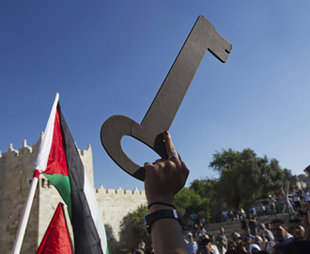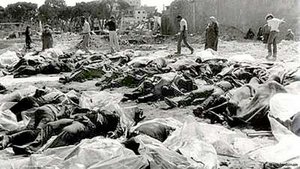An Objective Delineation of Events
Of course, this book about the Naqba has to include the keys – the big rusty keys to their former homes which exiled Palestinians still show, almost as a reflex, as a symbol for the injustice they and their families experienced in 1948 at the hands of the emerging state of Israel.
The keys are at the centre of many books on the Naqba, the catastrophe, as the Palestinians call the founding of the state of Israel in 1948. But this expressive symbol of their suffering has lost some of its power, since a solution of the Middle East conflict – however it comes about – will certainly not include a return of the refugees to their old villages and homes on Israeli territory.
So it's indeed positive that the Swiss journalist, Marlène Schnieper, makes sparing use of emotional clichés such as the keys in her book "Nakba – die offene Wunde" ("Naqba – The Open Wound"). She succeeds in making clear her sympathy for the Palestinians on the one hand, while on the other remaining objective in her delineation of events.
Research of the Israeli New Historians

Schnieper describes thoroughly and precisely the near-civil-war conditions under which the state of Israel was founded. She insists that the Arab states were a good deal less united, armed or determined when they went to war after Israeli independence than their martial rhetoric implied. ("However many Jews there are there, we will throw them in the sea," said Abd al-Rahman Azzam Pasha, the first secretary-general of the Arab League.)
For her description of events, Schnieper relies mainly on the research of the Israeli New Historians who have called the founding myths of the state into question since the late 1980s. Among those myths was the belief that the Palestinians left their homes voluntarily before Israeli independence. Schnieper describes how the planned and sometimes brutal expulsion of Palestinians in individual incidents led to a chain reaction in the whole country. News and rumours about the massacre at Deir Yassin, for example, led many Palestinians to flee their homes.
On 9th April, 1948, members of the Zionist underground organisations Irgun and Lehi killed between 100 and 120 people in the village near Jerusalem; rumours spread quickly which doubled the number of dead and added reports that the women had been raped.
Linking individual fates to broader history

Hasan Hammami tells Schnieper in the book that it was the reports from Deir Yassin which had led his family to flee. His is one of six family stories in the book, telling how 1948 changed their lives, and linking individual fates to the broader history.
The Hammamis were a prosperous family of fruit traders from Jaffa. They fled to Lebanon, leaving their house and a large part of their wealth behind them. They had good contacts in Lebanon, and so they did not have to live in a refugee camp as did so many others. Hasan Hammami and his sister were able to take up successful professional careers. "Not bad for refugee children, eh?" he tells Schnieper.
It's one of the strengths of the book that it doesn't show the Palestinians just as passive victims who merely succeed more or less in coming to terms with the injustice done to their families. There's a casual worker who always has to rely on getting another work permit in Israel if he is to make ends meet.
There's the father in the Balata refugee camp on the West Bank who has lost both his sons: after one had been killed in an Israeli attack, the other decided to take revenge by becoming a suicide bomber and was killed by Israeli soldiers before he could carry out his mission. There's a Bedouin family which doesn't feel that anyone in the region represents their interests.
Biographical cross-section of Palestinian society
They are all allowed to tell their stories at length, as does Sari Nusseibeh, the maverick philosopher from an old aristocratic Jerusalem family, or Ahmad Yousef, intellectual adviser to the Hamas government of Gaza – an Islamist who says the best time of his life was the time he spent in Washington.

It's this biographical cross-section of Palestinian society which makes this book so worth reading. Schnieper lets these life stories repeatedly show how the history of 1948 still has an effect today and how patterns repeat themselves as they continue to influence the Middle East conflict – from the divisions in the Palestinian leadership and the lack of support from the Arab states to the continuing land grab by Israel and its settlers, supported by the country's military superiority.
None of this is really new, and anyone who has looked at the Middle East conflict before will find many things they already know as they read the book. It's highly to be recommended for beginners: anyone who wants to understand what the founding of the state of Israel meant for many Palestinians will find that this book gives them a readable insight – made more useful by a thorough chronology and a glossary.
Moritz Behrendtz
© Qantara.de 2012
Translated from the German by Michael Lawton
Marlène Schnieper: Nakba – Die offene Wunde. Die Vertreibung der Palästinenser 1948 und die Folgen (Naqba – The Open Wound: The Expulsion of the Palestinians in 1948 and its consequences), Rotpunktverlag, Zürich 2012, 380 Seiten, 28 Euro